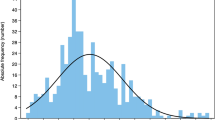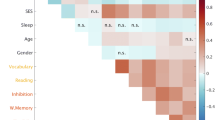Abstract
A novel battery (BAFE; Valeri et al. 2015) was used in order to assess three executive function (EF) abilities (working memory, inhibition and shifting) in a sample of 27 intellectually able preschoolers with autism spectrum disorder (ASD) compared with 27 typically developing children matched on age and nonverbal IQ. Differences in EF skills were analyzed in participants with distinct ASD symptom severity. Children with ASD performed worse than typical controls on both set-shifting and inhibition, but not on visuo-spatial working memory. Additionally, children with more severe ASD symptoms showed a worse performance on inhibition than children with milder symptoms. These results confirm the presence of EF deficits and highlight a link between ASD symptoms and EF impairments in preschool age.
Similar content being viewed by others
References
Alloway, T. P., & Alloway, R. G. (2013). Working memory in development. In T. P. Alloway & R. G. Alloway (Eds.), Working memory: The connected intelligence (pp. 63–82). New York: Psychology Press.
American Psychiatric Association. (2013). Diagnostic and statistical manual of mental disorders (5th ed.). Washington, DC: Author.
Barkley, R. A. (2012). Executive functions: What they are, how they work, and why they evolved. New York: Guilford Press.
Best, J., & Miller, P. (2010). A developmental perspective on executive function. Child Development, 81(6), 1641–1660. https://doi.org/10.1111/j.1467-8624.2010.01499.x.
Carlson, S. M. (2005). Developmentally sensitive measures of executive function in preschool children. Developmental Neuropsychology, 28(2), 595–616.
Carlson, S. M., & Moses, L. J. (2001). Individual differences in inhibitory control and children’s theory of mind. Child Development, 72(4), 1032–1053.
Daunhauer, L. A., Fidler, D. J., Hahn, L., Will, E., Lee, N. R., & Hepburn, S. (2014). Profiles of everyday executive functioning in young children with Down Syndrome. American Journal on Intellectual and Developmental Disabilities, 119, 303–318. https://doi.org/10.1352/1944-7558-119.4.303.
Dawson, G., Meltzoff, A. N., Osterling, J., & Rinaldi, J. (1998). Neuropsychological correlates of early symptoms of autism. Child Development, 69(5), 1276–1285.
Dawson, G., Munson, J., Estes, A., Osterling, J., McPartland, J., Toth, K., et al. (2002). Neurocognitive function and joint attention ability in young children with autism spectrum disorder versus developmental delay. Child Development, 73(2), 345–358.
D’Cruz, A., Ragozzino, M., Mosconi, M., Shrestha, S., Cook, E., & Sweeney, J. (2013). Reduced behavioral flexibility in autism spectrum disorders. Neuropsychology, 27(2), 152–160. https://doi.org/10.1037/a0031721.
Demetriou, E. A., Lampit, A., Quintana, D. S., Naismith, S. L., Song, Y. J. C., Pye, J. E., et al. (2018). Autism spectrum disorders: A meta-analysis of executive function. Molecular Psychiatry, 23, 1198–1204.
Diamond, A. (2013). Executive functions. Annual Review of Psychology, 64, 135–168.
Diamond, A. (2016). Why improving and assessing executive functions early in life is critical. In J. A. Griffin, P. McCardle, L. S. Freund, J. A. Griffin, P. McCardle, & L. S. Freund (Eds.), Executive function in preschool-age children: Integrating measurement, neurodevelopment, and translational research (pp. 11–43). Washington, DC: American Psychological Association. https://doi.org/10.1037/14797-002.
Diamond, A., & Taylor, C. (1996). Development of an aspect of executive control: Development of the abilities to remember what I said and to “Do as I say, not as I do”. Developmental Psychobiology, 29(4), 315–334.
Espy, K. A. (2004). Using developmental, cognitive and neuroscience approaches to understand executive control in young children. Developmental Neuropsychology, 26, 379–384.
Faja, S., & Dawson, G. (2014). Brief report: Performance on the dimensional change card sort and backward digit span by young children with autism without intellectual disability. Child Neuropsychology: A Journal on Normal and Abnormal Development in Childhood and Adolescence, 20(6), 692–699. https://doi.org/10.1080/09297049.2013.856395.
Frith, U. (1971). Spontaneous patterns produced by autistic, normal and subnormal children. In M. Rutter (Ed.), Infantile autism: Concepts, characteristics and treatment (pp. 113–135). London: Churchill Livingstone.
Frye, D., Zelazo, P. D., & Palfai, T. (1995). Theory of mind and rule-based reasoning. Cognitive Development, 10(4), 483–527.
Garon, N., Bryson, S., & Smith, I. (2008). Executive function in preschoolers: A review using an integrative framework. Psychological Bulletin, 134(1), 31–60. https://doi.org/10.1037/0033-2909.134.1.31.
Garon, N., Smith, I. M., & Bryson, S. E. (2018). Early executive dysfunction in ASD: Simple versus complex skills. Autism Research, 11(2), 318–330.
Gerstadt, C. L., Hong, Y. J., & Diamond, A. (1994). The relationship between cognition and action: Performance of children 3 1/2–7 years old on a stroop-like day-night test. Cognition, 53(2), 129–153.
Gotham, K., Pickles, A., & Lord, C. (2009). Standardizing ADOS scores for a measure of severity in autism spectrum disorders. Journal of Autism and Developmental Disorders, 39(5), 693–705. https://doi.org/10.1007/s10803-008-0674-3.
Gottesman, I., & Gould, T. (2003). The endophenotype concept in psychiatry: Etymology and strategic intentions. American Journal Of Psychiatry, 160(4), 636–645. https://doi.org/10.1176/appi.ajp.160.4.636.
Griffith, E. M., Pennington, B. F., Wehner, E. A., & Rogers, S. J. (1999). Executive functions in young children with autism. Child Development, 70(4), 817–832.
Happé, F., & Ronald, A. (2008). The fractionable autism triad: A review of evidence from behavioural, genetic, cognitive and neural research. Neuropsychology Review, 18, 287–304.
Hill, E. L. (2004a). Evaluating the theory of executive dysfunction in autism. Developmental Review, 24, 189–233.
Hill, E. L. (2004b). Executive dysfunction in autism. Trends in Cognitive Sciences, 8(1), 26–32.
Hughes, C. (1998). Executive function in preschoolers: Links with theory of mind and verbal ability. British Journal of Developmental Psychology, 16(2), 233–253.
Hughes, C., Ensor, R., Wilson, A., & Graham, A. (2010). Tracking executive function across the transition to school: A latent variable approach. Developmental Neuropsychology, 35, 20–36.
Kenny, L., Cribb, S., & Pellicano, E. (2018). Childhood executive function predicts later autistic features and adaptive behavior in young autistic people: A 12-year prospective study. Journal of Abnormal Child Psychology. https://doi.org/10.1007/s10802-018-0493-8.
Kimhi, Y., Shoam-Kugelmas, D., Ben-Artzi, G. A., Ben-Moshe, I., & Bauminger-Zviely, N. (2014). Theory of mind and executive function in preschoolers with typical development versus intellectually able preschoolers with autism spectrum disorder. Journal of Autism and Developmental Disorders, 44(9), 2341–2354.
Lee, K., Bull, R., & Ho, R. (2013). Developmental changes in executive functioning. Child Development, 84(6), 1933–1953. https://doi.org/10.1111/cdev.12096.
Lehto, J. E., Juujärvi, P., Kooistra, L., & Pulkkinen, L. (2003). Dimensions of executive functioning: Evidence from children. British Journal of Developmental Psychology, 21, 59–80. https://doi.org/10.1348/026151003321164627.
Lopez, B., Lincoln, A., Ozonoff, S., & Lai, Z. (2005). Examining the relationship between executive functions and restricted, repetitive symptoms of autistic disorder. Journal Of Autism And Developmental Disorders, 35(4), 445–460. https://doi.org/10.1007/s10803-005-5035-x.
Lord, C., Risi, S., Lambrecht, L., Cook, E. H., Leventhal, B. L., DiLavore, P. C., et al. (2000). The autism diagnostic observation schedule—Generic: A standard measure of social and communication deficits associated with the spectrum of autism. Journal of Autism and Developmental Disorders, 30(3), 205–223.
Lord, C., Rutter, M., & Couteur, A. (1994). Autism diagnostic interview-revised: A revised version of a diagnostic interview for caregivers of individuals with possible pervasive developmental disorders. Journal of Autism and Developmental Disorders, 24(5), 659–685. https://doi.org/10.1007/BF02172145.
Miyake, A., Friedman, N. P., Emerson, M. J., Witzki, A. H., Howerter, A., & Wager, T. D. (2000). The unity and diversity of executive functions and their contributions to complex “frontal lobe” tasks: A latent variable analysis. Cognitive Psychology, 41, 49–100.
Mosconi, M., Kay, M., D’Cruz, A., Seidenfeld, A., Guter, S., Stanford, L., et al. (2009). Impaired inhibitory control is associated with higher-order repetitive behaviors in autism spectrum disorders. Psychological Medicine, 39(9), 1559–1566. https://doi.org/10.1017/s0033291708004984.
Passler, M. A., Isaac, W., & Hynd, G. W. (1985). Neuropsychological development of behavior attributed to frontal lobe functioning in children. Developmental Neuropsychology, 1(4), 349–370.
Pellicano, E. (2007). Links between theory of mind and executive function in young children with autism: Clues to developmental primacy. Developmental Psychology, 43(4), 974.
Pellicano, E., Maybery, M., Durkin, K., & Maley, A. (2006). Multiple cognitive capabilities/deficits in children with an autism spectrum disorder: “Weak” central coherence and its relationship to theory of mind and executive control. Development and Psychopathology, 18(1), 77–98. https://doi.org/10.1017/S0954579406060056.
Reed, P., Watts, H., & Truzoli, R. (2013). Flexibility in young people with autism spectrum disorders on a card sort task. Autism, 17(2), 162–171. https://doi.org/10.1177/1362361311409599.
Roid, G., & Miller, L. (1997). Leiter international performance scale–revised. Wood Dale, IL: Stoelting.
Russell, J. (1997). Autism as an executive disorder. New York: Oxford University Press.
Smithson, P. E., Kenworthy, L., Wills, M. C., Jarrett, M., Atmore, K., & Yerys, B. E. (2013). Real world executive control impairments in preschoolers with autism spectrum disorders. Journal of Autism and Developmental Disorders, 43, 1967–1975. https://doi.org/10.1007/s10803-012-1747-x.
Stievano, P., Ciancaleoni, M., & Valeri, G. (2017). Italian executive functions battery for preschoolers (BAFE): Working memory, inhibition, set-shifting. Neuropsychological Trends, 22, 25–46.
Stievano, P., & Valeri, G. (2013). Executive functions in early childhood: Interrelations and structural development of inhibition, set-shifting and working memory. Neuropsychological Trends, 13(1), 27–45.
Stuss, D. T. (1992). Biological and psychological development of executive functions. Brain and Cognition, 20(1), 8–23.
Tabachnick, B. G., & Fidell, L. S. (2013). Using multivariate statistics. Pearson Education Limited: Pearson New International Edition.
Valeri, G., Stievano, P., Ferretti, M. L., Mariani, E., & Pieretti, E. (2015). BAFE Batteria per l’Assessment delle Funzioni Esecutive. Firenze: Hogrefe Editore.
Van Eylen, L., Boets, B., Cosemans, N., Peeters, H., Steyaert, J., Wagemans, J., et al. (2017). Executive functioning and local-global visual processing: Candidate endophenotypes for autism spectrum disorder? Journal of Child Psychology and Psychiatry, 58(3), 258–269. https://doi.org/10.1111/jcpp.12637.
Yerys, B. E., Hepburn, S. L., Pennington, B. F., & Rogers, S. J. (2007). Executive function in preschoolers with autism: Evidence consistent with a secondary deficit. Journal of Autism and Developmental Disorders, 37(6), 1068–1079.
Yerys, B. E., Wallace, G. L., Harrison, B., Celano, M. J., Giedd, J. N., & Kenworthy, L. E. (2009). Set-shifting in children with autism spectrum disorders: Reversal shifting deficits on the intradimensional/extradimensional shift test correlate with repetitive behaviors. Autism, 13, 523–538.
Zelazo, P. D. (2004). The development of conscious control in childhood. Trends in Cognitive Sciences, 8(1), 12–17.
Zelazo, P. D., & Müller, U. (2002). Executive function in typical and atypical development. Oxford: Blackwell Handbook.
Author information
Authors and Affiliations
Contributions
GV, LC, EN, PS, BT, SV, and TGS have made substantial contributions to conception and design, acquisition of data, analysis and interpretation of data, have been involved in drafting the manuscript and revising it critically for important intellectual content and have given final approval of the version to be published.
Corresponding author
Ethics declarations
Ethical Approval
All procedures performed in studies involving human participants were in accordance with the ethical standards of the institutional and/or national research committee and with the 1964 Helsinki declaration and its later amendments or comparable ethical standards.
Additional information
Publisher's Note
Springer Nature remains neutral with regard to jurisdictional claims in published maps and institutional affiliations.
Rights and permissions
About this article
Cite this article
Valeri, G., Casula, L., Napoli, E. et al. Executive Functions and Symptom Severity in an Italian Sample of Intellectually Able Preschoolers with Autism Spectrum Disorder. J Autism Dev Disord 50, 3207–3215 (2020). https://doi.org/10.1007/s10803-019-04102-0
Published:
Issue Date:
DOI: https://doi.org/10.1007/s10803-019-04102-0




